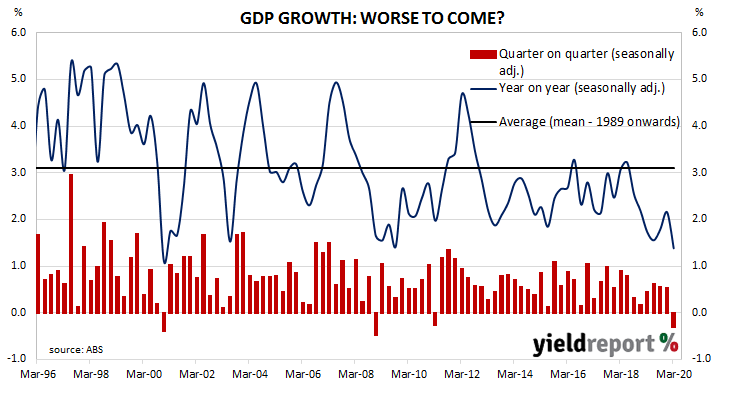Summary: GDP down 0.3% in March quarter; slightly better than expected; increased government spending and fewer imports counter big falls in household consumption, exports; worse expected in June quarter.
Since the “recession we had to have” as the recession of 1990/91 became known, Australia’s GDP growth has been consistently positive, with only the odd negative quarter here and there. Australia even managed to avoid two consecutive quarters of negative growth in the GFC period. However, almost nothing could prevent an economic contraction once a significant portion of the population began working from home as governments introduced limits on public places where people would typically congregate.
Figures released by the ABS indicate GDP contracted by 0.3% over the March quarter. It was a slightly better result than the 0.4% fall which had been generally expected but it was also a marked turnaround from the December quarter’s +0.5%. On an annual basis, GDP increased by 1.4%, down from the December quarter’s comparable figure of 2.2%.
Westpac senior economist Andrew Hanlan said the quarter represented “the first decline since March 2011 and, with a sharp fall likely in the June quarter, this will be the first back-to-back fall since the first half of 1991.”
 The figures came out on the same day as April’s dwelling approvals report and Commonwealth bond yields increased by more than their US Treasury counterparts had in overnight trading. By the end of the day, the 3-year Treasury bond yield had crept up 1bp to 0.28%, 3bps above the RBA’s target rate, while 10-year and 20-year yields had each gained 6bps to 0.95% and 1.61% respectively.
The figures came out on the same day as April’s dwelling approvals report and Commonwealth bond yields increased by more than their US Treasury counterparts had in overnight trading. By the end of the day, the 3-year Treasury bond yield had crept up 1bp to 0.28%, 3bps above the RBA’s target rate, while 10-year and 20-year yields had each gained 6bps to 0.95% and 1.61% respectively.
In the cash futures market, expectations of a rate cut hardened a little for contracts through to the end of 2020 but softened for months in 2021. By the end of the day, July contracts implied a rate cut down to zero as a 54% chance, unchanged from the previous day. August contracts implied a 48% chance of such a move in that month, also unchanged. December contracts implied a 42% chance, up from 40%. Prices of contracts during 2021 implied probabilities ranging between 33% and 42%.

